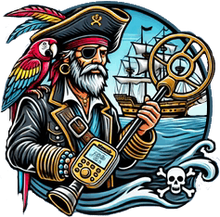The Spanish 1715 Fleet: Sunken Treasures Off Florida's Coast

The story of the Spanish 1715 Fleet is one of wealth, tragedy, and rediscovery. Over three centuries ago, on July 31, 1715, a convoy of 11 Spanish treasure ships sailing from Havana to Spain met their demise off Florida’s eastern coast. This catastrophic event was caused by a powerful hurricane, which scattered the fleet, sinking the ships and taking with them immense riches destined for the Spanish Crown. Today, this area is aptly named the Treasure Coast, and it remains one of the most enticing regions for treasure hunters and metal detecting enthusiasts.
What Treasures Were Onboard the 1715 Fleet?
The 1715 Fleet was loaded with incredible riches, reflecting the wealth of Spain’s colonies in the New World. These ships carried:
- Gold Coins: Spanish doubloons, minted in Mexico and South America, made up a significant portion of the cargo.
- Silver Coins: Pieces of eight, also known as Spanish reales, were the backbone of Spain’s colonial economy.
- Gold and Silver Ingots: These bars were destined to be recast in Spain.
- Jewelry: Intricately crafted items, including necklaces, rings, and religious artifacts, were being transported to wealthy patrons or for personal use by the crew and passengers.
- Uncut Emeralds and Other Gems: One of the lesser-known aspects of the 1715 Fleet is its cargo of precious gemstones, including emeralds from Colombia. Many of these remain hidden, waiting to be rediscovered.
- Artifacts: Ceramics, personal items, and navigational tools provide a glimpse into life aboard these ships.
Discovering Treasures in the Water
The Treasure Coast is a haven for underwater metal detecting. Modern treasure hunters have uncovered thousands of coins, gold chains, and ornate artifacts from the seabed. Using advanced metal detectors like the Minelab Excalibur or Nokta Makro Legend, you can scan submerged shipwreck sites or shallow waters along the coast. Areas near Sebastian Inlet and Vero Beach are especially promising, as these locations are close to known wreck sites.
When metal detecting in water, be sure to:
- Follow Local Regulations: Florida has strict rules about treasure hunting in certain areas. Permits may be required, and some locations are protected as historical sites.
- Use Waterproof Equipment: A detector designed for saltwater conditions is essential.
- Dive Safely: For deeper dives, always prioritize safety and consider working with a certified dive partner.
Finding Treasures Onshore
Even if you’re not venturing into the water, Florida’s beaches can yield incredible finds. Over the years, storms and shifting tides have washed treasures ashore, leaving them scattered along the sand. Using a reliable metal detector, you may uncover coins, small artifacts, and even uncut emeralds. In fact, many treasure hunters have found emeralds and other gemstones simply by walking the beach and keeping a sharp eye out.
Key tips for beach hunting include:
- Search After Storms: Hurricanes and strong weather patterns often churn up the seabed and deposit treasures along the shore.
- Focus on High-Tide Lines: These areas are more likely to collect items washed ashore.
- Bring a Sand Scoop: A scoop will make it easier to sift through sand for smaller treasures.
One notable discovery onshore includes the famous emerald ring found by treasure hunter Gary Drayton. This exquisite artifact, unearthed on the beach, features a large uncut emerald set in gold. It is a shining example of the treasures still waiting to be found along the Treasure Coast.
Join the Adventure
The Spanish 1715 Fleet represents one of the greatest treasure troves in maritime history. Whether you’re an experienced treasure hunter or a curious newcomer, the Treasure Coast offers an unparalleled opportunity to connect with history. With a bit of patience, the right equipment, and an adventurous spirit, you might find yourself holding a piece of history in your hands—perhaps even a glittering emerald from centuries past.
The treasures discovered from the 1715 Fleet are as diverse as they are remarkable. Examples include gold doubloons and silver reales, often in pristine condition despite centuries underwater. Ornate gold chains, some stretching several feet in length, have been recovered from the seabed, as well as intricate jewelry such as gold rings and pendants, many encrusted with gemstones. Treasure hunters have also found religious artifacts, including gold crosses and chalices, which highlight the spiritual significance of the time. Onshore, uncut emeralds have been unearthed by beachcombers, glistening in the sunlight after being hidden for centuries. Additionally, small personal items such as buttons, coins, and navigational instruments have offered a tangible connection to the lives of those aboard the fleet.





Leave a comment